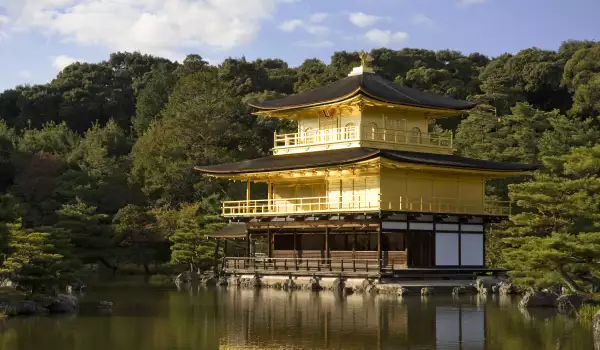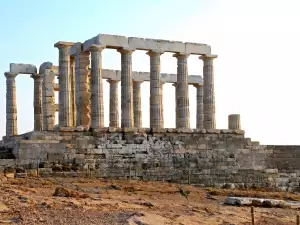Kinkakuji Temple

Kinkakuji Temple, known as the Golden Pavilion was built in 1397 as the residence of the shogun Ashikaga Yoshimitsu and after his death was turned into a Zen Buddhist temple. A visit to the Kinkakuji Temple, covered with gold embossed ornaments and surrounded by a beautiful Japanese garden is one of the mandatory things one must do in Kyoto. Situated at the foot of Mount Kinugasa, the Kinkakuji Temple is a wonderful masterpiece of the Muromachi era (14-16 century).
Golden Pavilion Temple in Kinkakuji literally shines in the color of the precious metal. The whole place is gilded, because it stores relics of Buddha. Over 3 000 temples can be seen in Kyoto. Even if you wanted to, one would hardly able to tour them all, but are advised to visit the castle Nijo, which is a monument of world importance and built by the Tokugawa shogun, the temple Kyumitsu or "Temple of pure water" from the 8th century, which is one of the most famous in Japan and inspired by Kinkakuji Silver pavilion known as Ginkakuji Temple - presently also a Zen complex.
Kinkakuji Temple was built in 1397 as a suburban villa of the shogun, who was the most powerful ruler of the dynasty Ashikagai and a theater patron. The Golden Pavilion is the place where Emperor Yoshimitsu was crowned. After his death, his son turned the villa into a temple, which is formally called Rokuon-ji. The construction of Kinkakuji Temple is with a three storey rectangular roof meeting in a central point. The walls were covered with a gold layer, which attaches great royalty and a halo of elevation to the pavilion.
Three floors of the Kinkakuji Temple are constructed in completely different styles. The first floor, called The Chamber of Dharma Waters, was built in the style shinden-zukuri, which follows the prescriptions of residential buildings. The second level is called The Tower of Sound Waves, was used as the residence of samurai and is made in the spirit of the Japanese military architecture. The third floor is in a traditional Chinese style cha'an.
Over the centuries, the construction of the pavilion was rebuilt several times and it managed to resist all the battles, wars, predatory attacks, earthquakes and other disasters for more than five hundred and fifty years. But in 1950 Kinkakuji was burned to the ground. Absolute copy of the burnt Kinkakuji Temple appeared soon after, the new building was also gilded later.
The lovely Japanese garden that surrounds Kinkakuji completes this spiritual complex, built entirely in the style of the Muromachi. In front of the pavilion was built a small pond that is surrounded by small lanes, streams and exotic vegetation. The largest island in the lake symbolizes the Japanese islands. Amid the water are placed four large stones near the Golden Temple, which in turn, according to Japanese mythology, should symbolize the night moored boats that travel to the island of eternal life.
This garden has been designated as special national historic site with a unique landscape. It is built entirely on the prescriptions of the so-called Western Paradise of the Buddha Amida, which seeks to bring harmony between heaven and earth. The garden of Kinkakuji pavilion itself forms one of the most popular resorts in Kyoto, as the park is one of a total of 17 places, which are the subject of World Heritage in Kyoto.















